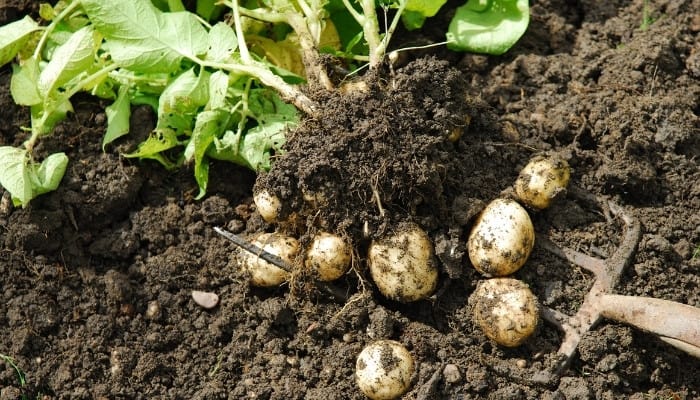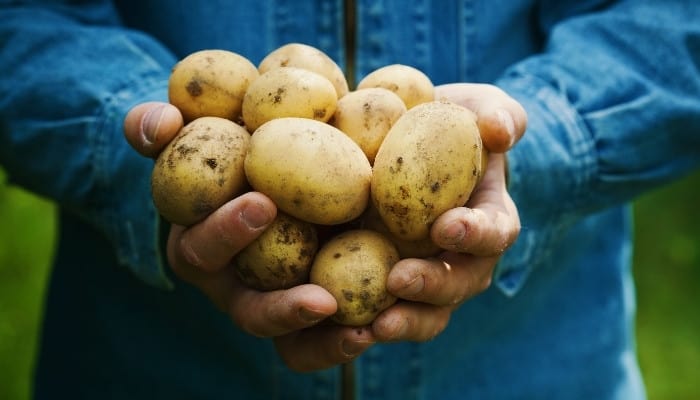Individuals new to gardening may find potatoes daunting. These root vegetables are challenging to harvest since they grow underground, making it challenging to determine when they are ready for picking.
Fortunately, they have built-in timers that let you know exactly when to grab your gardening fork.
When do you harvest potatoes? Soft-skinned, new, baby potatoes are ready to be harvested 2-3 weeks after the plants bloom. Maincrop potatoes have fully matured and are ready for harvest when the foliage withers and dies 4-5 weeks after blooming. This can be anywhere from June to September, depending on the variety.
Of course, there’s more to harvesting the humble potato than just looking for a flower. Keep reading for a crash course on harvesting, curing, and storing your spuds.
When (& How) To Harvest Potatoes
Unfortunately for fledgling potato farmers, the fact that the spuds snuggle deep underground can make it difficult to determine just the right time to harvest the so-called “earth apples.”
But, fear not! There are plenty of signs that let you know when your potatoes are ripe for the picking.
Signs It’s Time To Harvest Potatoes
Like Jerusalem artichoke and yams, the part of the potato plant that we harvest is called a “tuber.”
They’re specialized, swollen stems that serve an essential purpose in the life cycle of these herbaceous annuals.
As potatoes grow, they pull nutrients out of the stems and leaves to store for cold weather months, killing off the top part of the plant as the underground portion continues to grow.
By monitoring the foliage, you can predict when your potatoes have matured. Once the top of the plant is dead and there are no more nutrients available, the tubers have reached their full potential.
What Do Potato Plants Look Like When Ready To Harvest?
Whether you’re interested in harvesting tender, delicate new potatoes or the hardy maincrop potato, you’ll want to pay close attention to the visible portion of the potato plant to time your harvest correctly.
Once the flowers bloom, it’s a sign that your potato plant has started producing soft-skinned new potatoes. If you harvest in the next 2-3 weeks, you’ll find tubers that are delicate and small enough to be eaten whole.
For larger, more resilient maincrop potatoes, you’ll need to wait an additional 4-5 weeks. During this time, the foliage will begin to turn yellow, then brown, until it eventually shrivels up and dies.
When the leaves and stem are entirely dead, your spuds have developed a robust skin that is thick enough to withstand storage throughout the winter.
How To Harvest Potatoes
When it’s time to reap the fruits (or vegetables) of your labor, be aware that there are critical differences in how you harvest new vs. maincrop potatoes.
Harvesting New Potatoes
- Put on gloves to protect your hands.
- Push your hands into the sides of a potato hill or the growing container. You’ll need to be 4-6 inches under the surface of the soil.
- Feel around for potatoes you want, then gently pluck them off of the plant. Leave some of the potatoes underground to mature.
- Pat the soil back into place and water.
- If storing, place in a room with a maintained temperature of 35-40℉. Eat within two months.
Harvesting Maincrop Potatoes
- When the foliage starts to yellow and the flowers fall off, stop watering your plants. This prompts the potato skin to thicken.
- Wait two more weeks to allow the potatoes enough time to fully mature.
- Use a shovel or gardening fork to overturn one of your potato hills completely. Carefully dig down around the edges of the hill to avoid damaging the potato skins.
- Check the size and overall health. Rub your thumb over the skin of one of the potatoes. If it peels away, they’re not ready yet. Leave the rest of your plants to mature for a few more days.
- If they are mature, continue overturning your hills. Be sure to check in the soil for potatoes that may have fallen off during the growth or harvesting process.
- Once you harvest all of your potatoes, there’s no need to brush off the excess soil. It can stay on during curing. NEVER wash garden potatoes until you’re ready to use them.
- Take your potatoes out of the sun as soon as possible. Otherwise, you risk them turning green and bitter, as sunlight activates the toxic compound solanine in the plant.
Curing Potatoes
- Arrange your potatoes in a single layer in boxes lined with newspaper.
- Cover the boxes with a thin towel that allows air to circulate while still keeping out light.
- Store the boxes in a dark, dry place that maintains temperatures between 45-60℉. A basement works best.
- Leave them there for two weeks, during which time the skin will continue to thicken.
- After the waiting period, brush all excess soil off of the potatoes.
Storing Potatoes
In the right conditions, stored potatoes can last up to eight months.
- Scope out the right storage place. Most people use their basement or an insulated, outdoor shed.
- Ensure that the area is entirely dark to avoid solanine production.
- Set up box fans to provide adequate airflow.
- Create an environmental temperature of 45-50℉. This helps prevent microbes from growing but isn’t so cold that it causes dark spots on the spuds.
- Install a humidifier (I use this one) to prevent the potatoes from drying out. The sweet spot is 85-95% relative humidity. You can also put pans of water near the fans for a DIY humidifier.

What Happens If You Harvest Potatoes Too Early?
It might be tempting to harvest your potatoes long before the threat of the first frost, but waiting at least until the potato flowers bloom is crucial.
If you harvest potatoes too early, they will be too small and not nearly as enjoyable to eat.
How Long Can Potatoes Stay in the Ground?
Once they’ve reached their fully mature size, potatoes can stay in the ground for up to two more weeks. Over time, though, excessive moisture from the soil can do significant damage to your crop.
When left in wet conditions, the potatoes are prone to freezing, rot, microbe growth, and resprouting.
What Is the Best Month To Harvest Potatoes?
The best month to harvest potatoes depends on which variety you planted and the climate in your region as potatoes need temperatures of 60-70℉ for optimum growth.
Typically, you can harvest early potatoes in June or July, mid-season potatoes in late July to early August, and maincrop potatoes in late August to mid-September.
Can You Dig Potatoes Before They Have Flowered?
If you dig potatoes before they have flowered, you would be lucky to find any potatoes at all!
At the end of a potato plant’s life cycle, clusters of pink, white, or purple potato flowers bloom to spread seeds for reproduction.
These flowers are a sign that the plant has matured enough to produce tubers.
How Deep Do Potatoes Grow?
Potatoes grow at a depth of 6-8 inches, which is why they are a popular choice to cultivate in growing bags or buckets.
Be careful with your shovel or fork at harvest time to avoid doing damage to deep potatoes.
Related Questions:
When To Harvest Sweet Potatoes?
When harvesting sweet potatoes, wait until the leaves and vines transition from green to yellow. Harvest sweet potatoes just as you would regular potatoes.
When To Harvest Potatoes in Pots?
When you grow potatoes in pots, new potatoes are ready before the flowers bloom. Just feel through the soil to find the tubers you want and leave the rest to mature.
For storing potatoes, wait until the flowers open and then turn yellow.
Conclusion
Want to harvest picture-perfect potatoes?
As soon as the buds bloom, new potatoes are ready for picking. For potatoes that last the whole winter (and then some), wait for the above-ground stalks to turn brown and die.
That’s really all there is to it!

